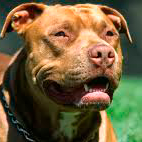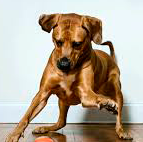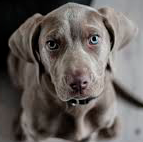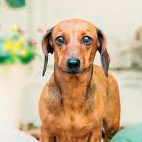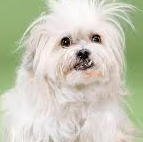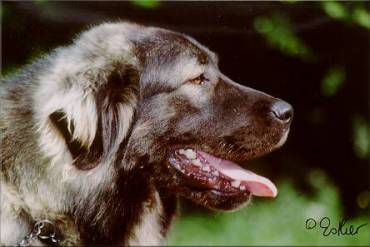
Sarplaninac
Sarplaninac pictures ➜
HISTORY
The Sarplaninac (pronounced sharplaneenetz), (Yugoslavian Shepherd Dog Sharplanina — Jugoslovenski Ovcarski PasSarplaninac) has been bred since time immemorial in the southeastern mountain regions of Yugoslavia. The breed is named after the Sharplanina Mountain Range, where it is most common. Today, Sarplaninacs are being bred all over the country. The breed had been registered with the FCI since 1939 under the designation “Illirski Ovcar” (Illyrian Shepherd Dog). In 1957, the General Assembly of the FCI accepted a motion proposed by the Yugoslavian Federation of Cynology to change the name of the breed to “Yugoslavian Shepherd Dog Sharplanina.”
The origin of the breed remains controversial. It seems likely that it came to Europe from Asia in the course of the prehistoric mass migrations. The original breed type has been maintained solely in the parts of the country where intense cattle breeding is still prevalent, where this dog can still play its original role of guardian and protector of cattle herds against predatory animals.
The Sarplaninac was recognized by the United Kennel Club on January 1, 1995.
GENERAL APPEARANCE & CHARACTERISTICS
The Sarplaninac is a robust, well-proportioned dog with plenty of bone. Well above average size, it has a thick, long, rather coarse coat that emphasizes the short-coupled appearance. The breed has a sturdy constitution, an even disposition, a good temperament, and is reliable and protective, but not snappy. It is incorruptible and devoted to its master.
Minor faults: Minor physical blemishes.
Serious faults: Lymphatic constitution. Any severe physical faults.
HEAD AND SKULL
The head is in proportion to the body. Its total length measures approximately 10 inches (25 cm.), which corresponds to about 40% of the height, measured at the withers. The skull is slightly longer than the muzzle (the relation being 57:43). The skull is broad, with a well-marked grove. In profile, as well as from above, the skull appears slightly convex and a little rounded. The eyebrows (superciliary ridges) are only slightly marked. The occiput is not evident. The stop is slight.
The broad muzzle is shorter than the skull. It is deep at the root, slightly tapering towards the nose. The nasal bone is straight and broad. The underjaw, in profile, starts with a bend and then proceeds in a straight line, diverging from the profile of the nasal bone. The lines of the profiles of the topline of the skull and the muzzle are converging.
The lips are moderately thick and tight. The upper lip only slightly overhangs the under lip. The corners of the lips are clean without even a hint of a flew.
Minor faults: Insufficiently broad skull. Jaws too heavy.
Serious faults: Muzzle too long. Muzzle too snipey.
TEETH
A full complement of strong, white teeth meet in a scissors bite.
Serious fault: Level (pincer) bite.
EYES
The almond-shaped eyes are neither large nor deep set. They may be dark or light in color, with a quiet, but piercing gaze that should never show fear. The lids and the visible connective tissues should be black.
NOSE
The nose is broad and black.
EARS
The ears are set on a line running from the tip of the nose through the inner corner of the eye or slightly underneath. They are v-shaped and dropping, hanging close to the cheeks, and are covered with short, dense hair.
Serious faults: Ears set too high. Ears standing off (not hanging close enough to the cheeks).
NECK
The crest is either slightly convex or straight. The throatline is straight. The neck is of medium length, but because of the length and thickness of the coat it looks shorter than it really is. Broad, deep, and muscled, it merges smoothly into the head and shoulders, and is carried slightly above the line of the back.
The skin is tight and without dewlaps. The coat of the neck is dense, long and coarse, with a marked frill at the nape (the junction of the head and the neck), broadening the width and depth of the neck.
FOREQUARTERS
The different parts of the forequarters are well-proportioned to each other and to the body. The fairly long, broad, flat shoulders are sloping, forming an angle of 65 degrees with a horizontal line. The elbows are at about 55% of the total height, measured at the withers. The elbow joint is broad and placed only very slightly off from the rib cage, turning neither in nor out.
FORELEGS
The forelegs are straight and well-proportioned to the body. The upper arm (humerus) is more obliquely set than the shoulder blade, the angle with the horizontal line being 55 degrees. It joins the forearm at ’ an angle of 145 degrees. The forearm is straight and long, with plenty of bone and well-developed muscles, and feathering along the rear side. The slightly slanting pasterns are broad and strong.
Minor faults: Any slight deviation of the limbs from the correct position.
BODY
The total length of the body slightly exceeds the height, measured at the withers. The relation is about 8:10 for dogs, and 10:12 for bitches.
The backline is horizontal or slightly sloping towards the croup. Dogs bred in the mountains may be allowed a croup that lies slightly higher than the withers, but this is not a desirable feature.
The withers are moderately developed and broad. Their connection with the neck is powerful, and the passage from the withers to the neck is hardly noticeable.
The straight, broad back is not too long. The loin is shorter, broad, and muscular. The medium length, sloping croup is well-muscled.
The chest is deep and of medium length, with slightly sprung ribs. The brisket reaches to the elbows. The forechest is broad and muscular. The girth of the rib cage should exceed the height by at least 20%.
The belly is tucked-up and muscled. The lower profile gently rises from the front to the rear. The flanks are rather short, and with a pronounced groove.
Minor faults: Chest lacking in width and depth. Flat-sided (slab-sided). Barrel-shaped ribs.
Serious fault: Sway back.
HINDQUARTERS
Viewed from behind, the hind legs appear to stand evenly, slightly wider apart than the forelegs. Seen from the side, they also appear of even construction and fairly well-angulated.
HIND LEGS
The upper thigh is well-muscled, round, and obliquely placed, the angle with a horizontal line being similar to that of the shoulder.
The stifle joint is slightly less angulated than the scapulahumerus joint (about 125 degrees). The stifle is strong and broad. The strong lower thigh is also obliquely placed. It has long muscles and very bushy feathering.
The broad hock displays a rather open angle (about 130 degrees). The rear pastern (metatarsals) slants less than the pastern. Dewclaws are rare and should be removed.
Minor faults: Any slight deviation of the limbs from the correct position.
FEET
The feet are firm and oval-shaped, with well-arched and closed toes. The nails are strong and black. The tough, but elastic, soles are black.
Minor fault: Harefeet.
TAIL
The long tail reaches at least to the hock joint. The topline of the croup slopes gradually and evenly into the tail. The tail is strong at the root. It tapers to a tip, with feathering along the lower side. It is carried in a slight curve like a saber. When the dog is excited, the curve is accentuated, and the tail may be lifted above the line of the back.
Minor fault: Tail slightly too short.
Serious fault: Tail carried with a side bend.
COAT & SKIN
The head and front side of the legs are covered with short hair. The ears are covered with short, dense hair. The hair is long, almost flat, and somewhat coarse on the rump, at the rear side of the legs, and on the tail. The coat of the neck is dense, long and coarse, with a marked frill at the nape (the junction of the head and the neck). The forearm is feathered along the rear side. Under the guard hair, the abundant undercoat is short, dense, and of fine texture. At the withers the hair should measure between 4 and 4.75 inches (10 and 12 cm.); it should not be shorter than 2.75 inches (7 cm.).
The moderately thick, elastic skin is tight all over the body, without dewlaps. All the visible mucous membranes are black and deeply pigmented.
Minor faults: Coat slightly shorter than desired, as long as the feathering is correct. White markings on the chest and feet.
COLOR
The Sarplaninac is a solid-colored dog. All colors are acceptable from white to a dark brown that looks almost black. The preferred shades are iron gray (a greenish-gray) and dark gray. The upper part of the head, the neck, and the body are of a darker hue that fades out into a dirty white or a yellowish gray toward the extremities. The change must be very gradual and by no means give the impression of a spotted pattern or actually create a spotted coat. Spotting and white markings are not allowed. Pigmented dogs may show tiny white markings at the chest and toes, but they are not desirable.
HEIGHT & WEIGHT
The average height for males, measured at the withers, is 24.5 inches (62 cm). Males under 22 inches (56 cm.) are not eligible for breeding. The average height for females, measured at the withers, is 2.75 inches (58 cm.). Females under 21.25 inches (54 cm.) are not eligible for breeding.
Males in good working condition weigh between 77 and 99 pounds. (35 and 45 kg.) Females in good working condition weigh between 66 and 88 pounds (30 and 40 kg.).
GAIT
The stride is long and elastic. The characteristic and most usual gait is the trot, with a high and moderately outreaching action. At a gallop, the dog appears to be somewhat clumsy, but the jumps are long and cover plenty of ground.
DISQUALIFICATIONS
Unilateral or bilateral cryptorchid. Extreme viciousness or shyness. Missing premolars. A striking disproportion between the length of the body and the height. Males under 22 inches (56 cm.) in height. Females under 21.25 inches (54 cm.) in height. Hair shorter than 2.75 inches (7 cm.). White markings (spotting). Brindle pattern. Unpigmented visible mucous membranes and eyes. Any feature betraying a degeneration. Severely cowhocked. Undershot bite. Overshot bite. Bobtails (including dogs born with only a stump, or no tail at all). Severe sway back.










